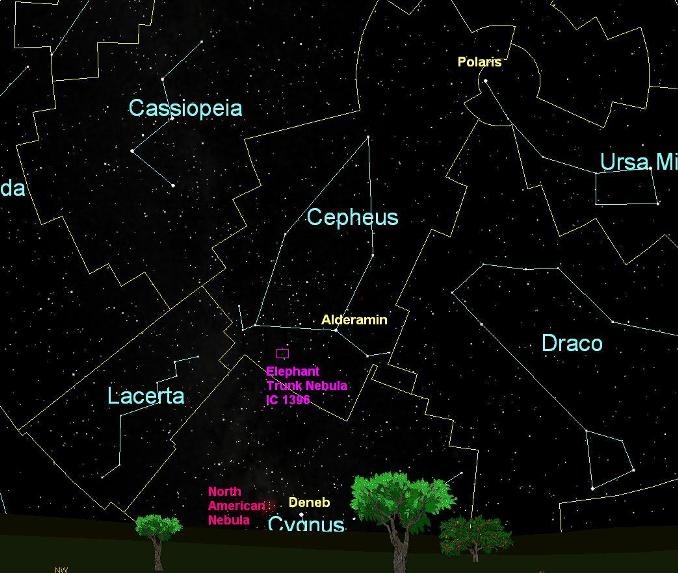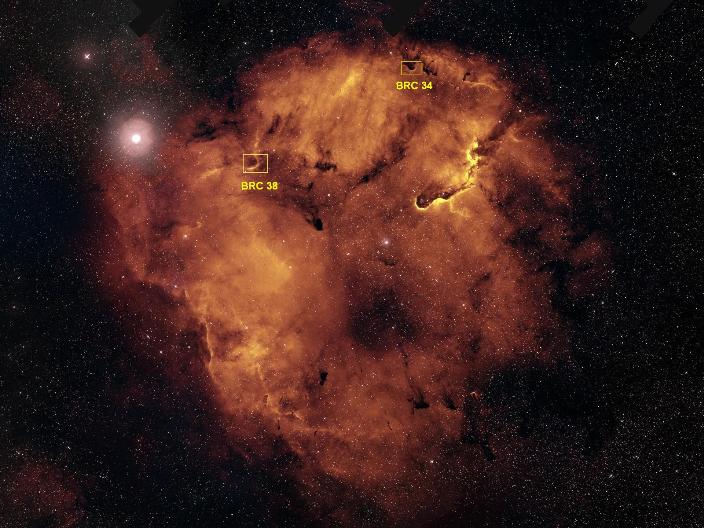Bob BRC 34
Contents
Location of BRC 34
As a Planetarium teacher, I wanted to know where BRC 34 was located in the sky. What constellation it was in? (Cepheus the King) What was the nearest bright star? (Alderamin & Deneb)
The image below was created using Starry Night software and Paint.
Below is a picture of the locations of BRC 34 & 38 in IC 1396--the Elephant Trunk Nebula. I am not 100 percent sure if I got the positions correct. If anyone can double check that would be helpful.
It is curious to see the 38's brighter rim compared to 34's.
BRC 34 FINDINGS
From last year’s NITARP team proposal we have the following information on BRC 34.
Sugitani (1991)
LOCATION: RA 21h 32m 51.2s DEC +58d 08m 43s
Located in IC 1396 (Elephant Trunk’s Nebula)
DISTANCE: 0.75 kilo parsecs or 2,400 light years
CLASSIFICATION: Type A BRC
Ogura (2002)
STARS: Found two Hα emission stars found in BRC 34.
Morgan (2004)
Defined the boundary layer of BRC 34. No 20-cm emission was associated with the rim of BRC 34. They used archival data from IRAS, NRAO/VLA Sky Survey (NVSS), Digitized Sky Survey (DSS) and the mid-course Space experiment (MSX).
Valdettaro et al. (2005)
Did not detect water maser emissions indicative of YSOs at 22.2 GHz. They surmised that the negative results were due to the emission from the heated dust near the head of the BRC. This might also be indicative of low-mass star formation.
Morgan et al. (2008)
Found that BRC 34 did not include any T-Tauri stars nor any class I YSO candidates. They proposed that the lack of YSOs might be due to the protostellar core being at the early stages of evolution. They used SCUBA data and supplemented their findings with NASA/IPAC Infrared Science Archive data – IRAS at 12, 25, 60 and 100 μm and Two-Millimeter All-Sky Survey (2MASS) at JHKs bands. A search of the 2MASS catalog by Morgan (2008)
Morgan et al.(2009)
Eliminated BRC 34 as a good candidate for radiation driven implosion and suggested its evolution would not be affected by nearby OB stars. They used CO spectra and previous work to obtain this conclusion.
FURTHER RESULTS for BRC 34
Barensten (2011)
BRC 34 is defined as bright-rimmed cloud D. Though this study tripled the number (158) of classical T Tauri candidates in the IC 1396 region, most were found by bright-rimmed clouds A/B and E (BRC 38). According to Figure 9 in their study, no candidates were found near BRC 34.
Other results revealed that 56 per cent of the candidates below 0.5M—or low mass stars. Found strong indication that the formation of these clusters has been sequentially triggered by the massive star HD 206267.
Johnson 2012
This study from last year’s NITARP team found 8 new candidates for YSOs in BRC 34. There was one known before their study. Most of these YSOs (6) were classified in the flat class.
Saurin 2012
There is no direct mention of BRC 34 here, though it was studied. Indirectly we might conclude that BRC 34 has a lower central density, suggesting even smaller star clusters(?) based on the study’s finding that “BRC33, BRC36, BRC37, BRC38 and BRC39 have profiles with relatively high central density, suggesting small star clusters.”
Nagano 2012
Again, this paper did not find much activity in BRC 34 though it does state, “Some Hα stars appear to be associated with other small bright rimmed clouds such as Rim C and SFO 34 (Rim D).”
It adds though, “ total of 639 Hα emission-line stars were detected in an area of 4.2 deg2 and their i′-photometry was measured. Their spatial distribution exhibits several aggregates near the elephant trunk globule (Rim A) and bright-rimmed clouds at the edge of the H ii region (Rim B and SFO 37, 38, 39, 41), and near HD 206267, which is the main exciting star of the H ii region.”
CONCLUSION
The 2011 proposal concluded with “we will investigate the properties of this object (BRC 34) with Spitzer archival data, and compare the number of YSO candidates found here with our other target, BRC 27. The literature suggests that we will find fewer YSO candidates here than in BRC 27.
The latest research seems to suggest that this will be the case for our study in 2012--although does the WISE data in anyway suggest a different conclusion?
Historical Narrative of IC 1396
I just found this an interesting take on the region that contains BRC 34 & 38. From the website: (http://www.robgendlerastropics.com/IC1396text.html)
IC 1396 is a large HII region in the constellation Cepheus spanning 3 full degrees of winter sky, the same angular distance of 6 full moons. It formed at the southern edge of an enormous 400 light year bubble of molecular gas known as the Cepheus bubble. Amazingly the IC 1396 complex is illuminated by a single massive star, the class O6 star HD206267, a blue supergiant located in the center of the donut shaped emission cloud. HD206267 is member of the cluster, known as Trumpler 37, believed to be the core of the expansive Cepheus OB2 association. HD206267 is a trapezium type stellar system with HD206267 as the dominant ultraviolet energy source with a smaller UV contribution from three cooler companion B0 type stars. The stars of the entire trumpler 37 cluster are about 7 million years old, although HD206267 formed more recently about 4 million years ago. A distinct feature of IC1396 is the radial arrangement of several bright rimmed globules that form a loose and slowly expanding ring around the illuminating stars. The ring of loosely arranged dark globules has a radius of about 40 light years with HD206267 at its center. The "comet-like" configuration of some of these dark structures has coined the descriptive term "cometary globule". Although several of the globules are optically conspicuous the most prominent is catalogued as IC 1396A. IC 1396A contains the well known reflection nebula vdB 142. Low and intermediate mass stars appear to be actively forming within the globules. The star formation within the globules has been induced by a process known as "radiation driven implosion" where the ultraviolet flux from a massive star like HD206267 compresses the cold molecular gas within the globules, thus triggering collapse of the cloud and subsequent formation of lower mass stars.
Attempts to trace the history of IC 1396 point to a complex interplay of equentially triggered star formation and cloud-cloud interactions. Events likely unfolded with an initial burst of star formation that occurred between 13 and 18 million years ago and gave rise to the first generation of stars which includes the existing nearby cluster NGC 7160. The more massive members from that first generation of stars went on to destroy themselves in supernovae explosions and no longer exist today. About 7 to 8 million years ago the effects of the first generation of supernova driven shock fronts and powerful stellar winds from existing stars created a huge 400 light year diameter bubble known as the Cepheus bubble. The expanding bubble compressed and flattened surrounding molecular clouds triggering a second burst of star formation which went on to form the Cepheus OB2 association some 7 million years ago. Also formed in this second generation of star formation were Trumpler 37 and its dominant star, HD206267 some 4 million years ago. Under the influence of the ionizing radiation field from the new star cluster, the HII cloud IC 1396 and its globules formed some 2 to 3 million years ago. Triggered by the expanding Cepheus bubble many well known HII regions have formed along its perimeter including IC 1396, Sh2-129, 133, 134, and 140. As IC 1396 expanded from the stellar winds of HD206267, surviving fragments of molecular clouds in the form of globules formed into an expanding ring around the central exciting star. The third and youngest generation of lower mass stars is currently forming within the dark globules of IC 1396 by the process of radiation driven implosion.
The bright yellow star just to the north of IC1396 is the supergiant mu cephei. It formed during the first generation of stars which created the Cepheus bubble. It has the distinction of being one of the most luminous stars in our galaxy, emitting 350,000 times the power of our sun.

